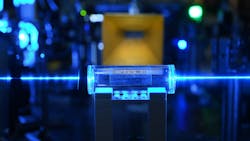Wanted: enabling technologies in atomic vapors for electric field sensing in electronic warfare (EW)
ARLINGTON, Va. – U.S. military scientists are reaching out to industry for enabling technologies to advance the performance of atomic vapors for electric field sensing for applications ranging from airborne electronic warfare (EW) to naval anti-submarine warfare (ASW).
Officials of the U.S. Defense Advanced Research Projects Agency (DARPA) in Arlington, Va., issued a broad agency announcement Wednesday (HR001120S0062) for the Science of Atomic Vapors for New Technologies (SAVaNT) project.
DARPA researchers are looking for high-performance atomic vapors for electric field sensing and imaging, magnetic field sensing, and quantum information science (QIS).
Atoms are constants of nature; they are not subject to manufacturing variabilities, defects, impurities, or aging, which makes them suitable for precision measurements, DARPA researchers explain.
One example involves atomic clocks, which are accurate to a fraction of a second over the age of the universe. Still, such high-precision quantum devices typically require laser-cooled and trapped atoms kept at microKelvin temperatures to mitigate thermal noise effects. This means laboratory-scale expansive setups.
Yet vapor-based technologies operate at or near room temperature without complex laser cooling and trapping, but still offer the advantages of the pristine nature of atoms.
The ability to manipulate atoms with light has advanced tremendously over the past couple of decades, and includes powerful quantum methods like electromagnetically induced transparency and spin exchange relaxation-free (SERF) magnetometry.
Scientists have used atomic vapors like Rydberg electrometry and SERF magnetometry for quantum information systems, and it may be possible to achieve additional significant breakthroughs in vapor-based devices.
Related: Enabling technologies for airborne electronic warfare
The DARPA SAVaNT program aims to develop techniques to mitigate main decoherence mechanisms to realize the full potential of atomic vapor based technologies. The program has three technical areas based on applications where atomic vapors should have the biggest benefit: Rydberg electrometry; vector magnetometry; and vapor quantum electrodynamics (VQED).
SAVaNT seeks new technologies for important military needs like low size, weight and power (SWaP), high-sensitivity electric and magnetic field measurements, and application that require scalable room-temperature quantum memories and interfaces. A common scientific challenge will be to improve atomic coherence in vapors, and will depend on dominant decoherence mechanisms.
SAVaNT will be a four-year program in two phases and three technical areas. The first phase focuses on demonstrating the physics of Rydberg electrometry; vector magnetometry; and vapor quantum electrodynamics.
The second phase will demonstrate an integrated benchtop physics package, and characterize technology tradeoffs of Rydberg electrometry; vector magnetometry; and vapor quantum electrodynamics.
Rydberg electrometry uses atoms to sense electric fields, and has notable advantages over antennas, such as extremely large operational bandwidth accessible with one device; potential for high sensitivity; and self-calibration. The focus is on improving sensitivity and instantaneous bandwidth of Rydberg electrometry.
Vapor magnetometers demonstrate one of the highest scalar magnetic field sensitivities of any device, yet it requires expansive magnetic shielding and complex active cancellation of ambient magnetic fields. The focus is on achieving vapor-based vector magnetometry of quasi-DC fields ranging from 100 Hz to 1 MHz with high sensitivity and accuracy in a small package.
Vapor quantum electrodynamics, meanwhile, seeks to demonstrate a room-temperature, vapor-based quantum electrodynamics platform in the strong-coupling regime.
DARPA experts will brief industry in details of the SAVaNT program in a Zoom webcast from 11 a.m. to 2 p.m. on 3 Sept. 2020. Register for the Zoom meeting online at https://events.sa-meetings.com/ehome/566075/home/.
Companies interested should upload abstracts no later than 11 Sept. 2020, and full proposals no later than 27 Oct. 2020 to the DARPA BAA website at https://baa.darpa.mil.
Email questions or concerns to Tatjana Curcic, the DARPA SAVaNT program manager, at [email protected].
More information is online at https://beta.sam.gov/opp/f66cc4e7b5cf4d28b5ec9977d87448a4/view.
About the Author
John Keller
Editor-in-Chief
John Keller is the Editor-in-Chief, Military & Aerospace Electronics Magazine--provides extensive coverage and analysis of enabling electronics and optoelectronic technologies in military, space and commercial aviation applications. John has been a member of the Military & Aerospace Electronics staff since 1989 and chief editor since 1995.
